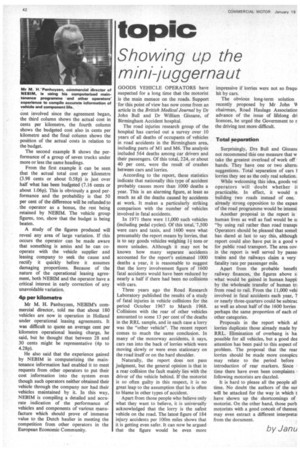topic
Page 44

If you've noticed an error in this article please click here to report it so we can fix it.
Showing up the mini-juggemaut
GOODS VEHICLE OPERATORS have suspected for a long time that the motorist is the main menace on the roads. Support for this point of view has now come from an article in the British Medical Journal by Dr John Bull and Dr William Gissane, of Birmingham Accident hospital.
The road injuries research group of the hospital has carried out a survey over 10 years of all deaths of occupants of vehicles in road accidents in the Birmingham area, including parts of M1 and M6. The analysis included 564 deaths among car drivers and their passengers. Of this total, 224, or about 40 per cent, were the result of crashes between cars and lorries.
According to the report, these statistics indicate that nationally this type of accident probably causes more than 1000 deaths a year. This is an alarming figure, at least as much as all the deaths caused by accidents at work. It makes a particularly striking comparison with the number of vehicles involved in fatal accidents.
In 1971 there were 11,000 such vehicles (including pedal cycles). Of this total, 7,500 were cars and taxis, and 1600 were what presumably the report means by lorries, that is to say goods vehicles weighing 1+ tons or more unladen. Although it may not be known how many separate accidents accounted for the report's estimated 1000 deaths a year, it is reasonable to suggest that the lorry involvement figure of 1600 fatal accidents would have been reduced by nearly a half if there had been no collisions with cars.
Three years ago the Road Research Laboratory published the results of a study of fatal injuries in vehicle collisions for the period October 1967 to March 1968. Collisions with the rear of other vehicles amounted to some 13 per cent of the deaths in the RRL sample, and in each case a lorry was the "other vehicle". The recent report comes to much the same conclusion. In many of the motorway accidents, it says, cars ran into the back of lorries which were moving slowly or were even stationary on the road itself or on the hard shoulder.
Naturally, the report does not pass judgment, but the general opinion is that in a rear collision the fault mainly lies with the driver of the vehicle behind. If the motorist is so often guilty in this respect, it is no great leap to the assumption that he is often to blame in other types of accident.
Apart from those people who believe only what they want to believe, it is universally acknowledged that the lorry is the safest vehicle on the road. The latest figure of 184 injury accidents per 100m miles shows that it is getting even safer. It can now be argued • that the figure would be even more
impressive if lorries were not so frequ, hit by cars.
The obvious long-term solution recently proposed by Mr John V chairman, Road Haulage Association advance of the issue of lifelong dri licences, he urged the Government to r the driving test more difficult.
Total separation
Surprisingly, Drs Bull and Gissan( not recommend this one measure that w take the greatest overload of work off • hands. They have one or two ahem suggestions. Total separation of cars I lorries they see as the only real solution.
While welcoming this idea, goods vel operators will doubt whether ii practicable. In effect, it would n building two roads instead of one. already strong opposition to the expan of the road programme would be intensi Another proposal in the report is human lives as well as fuel would be si "by using rail rather than road transp( Operators should be pleased that soma has dared at last to say this, although report could also have put in a good v for public road transport. The area coy in the report is well served by passe] trains and the railways claim a very fatality rate per passenger mile.
Apart from the probable benefit railway finances, the figures above s what would be gained in human happi. by the wholesale transfer of human tn from road to rail. From the 11,000 vehi involved in fatal accidents each year, 7 or nearly three-quarters could be subtrae as well as about half of the 1600 lorries perhaps the same proportion of each of other categories.
Proposals in the report which al lorries duplicate those already made by RRL. Elimination of overhang is ha possible for all vehicles, but a good des attention has been paid to this aspect of problem. The proposal that the rear lorries should be made more conspicu may relate to the period before introduction of rear markers. Since time there have even been complaints • following motorists are dazzled.
It is hard to please all the people all time. No doubt the authors of the sur will be attacked for the way in which t have shown up the shortcomings of motorist. On the other hand, those purb motorists with a good conceit of themse may even extract a different interpretai from the document.
by Jam,'




















































































































